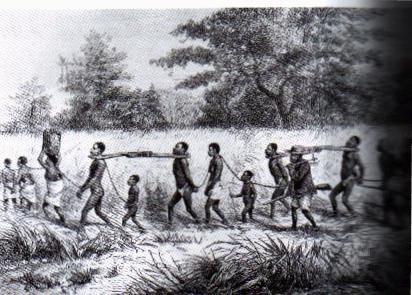
"I met a comfortably-dressed negro leading three others by a rope; the first was a middle-aged man; the second a girl of, perhaps, twenty; and the last a boy, considerably younger. The arms of all three were secured before them with hand-cuffs, and the rope by which they were led passed from one to another; being made fast at each pair of hand-cuffs. They were thinly clad, the girl especially so, having only an old ragged handkerchief around her neck, over a common calico dress, and another handkerchief twisted around her head."
SLAVES AS MERCHANDISE. A Journey in the Seaboard Slave States, Page 30.
The labor of this farm was entirely performed by slaves. I did not inquire their number, but I judged there were from twenty to forty. Their "quarters" lined the approach-road to the mansion, and were well-made and comfortable log cabins, about thirty feet long by twenty wide, and eight feet wall, with a high loft and shingle roof. Each, divided in the middle, and having a brick chimney outside the wall at each end, was intended to be occupied by two families. There were square windows, closed by wooden ports, having a single pane of glass in the center. The house-servants were neatly dressed, but the field-hands wore very coarse and ragged garments.
During three hours, or more, in which I was in company with the proprietor, I do not think there were ten consecutive minutes uninterrupted by some of the slaves requiring his personal direction or assistance. He was even obliged, three times, to leave the dinner-table.
"You see," said he, smiling, as he came in the last time, "a farmer's life, in this country, is no sinecure." This turning the conversation to Slavery, he observed, in answer to a remark of mine, "I only wish your philanthropists would contrive some satisfactory plan to relieve us of it; the trouble and the responsibility of properly taking care of our negroes, you may judge, from what you see yourself here, is anything but enviable. But what can we do that is better? Our free negroes--and, I believe it is the same at the North as it is here--are a miserable set of vagabonds, drunken, vicious, worse off, it is my honest opinion, than those who are retained in slavery. I am satisfied, too, that our slaves are better off, as they are, than the majority of your free laboring classes at the North."
That a slave woman is commonly esteemed least for her laboring qualities, most for those qualities which give value to a brood-mare is, also, constantly made apparent.*
* A slaveholder writing to me with regard to my cautious statements on this subject, made in the Daily Times, says:--"In the States of Maryland, Virginia, North Carolina, Kentucky, Tennessee and Missouri, as much attention is paid to the breeding and growth of negroes as to that of horses and mules. Further South, we raise them both for use and for market. Planters command their girls and women (married or unmarried) to have children; and I have known a great many negro girls to be sold off, because they did not have children. A breeding woman is worth from one-sixth to one-fourth more than one that does not breed."
pp. 55-56.
"Slave Labor" in F. L. Olmsted, A Journey in the Seaboard Slave States, 1853-1854.